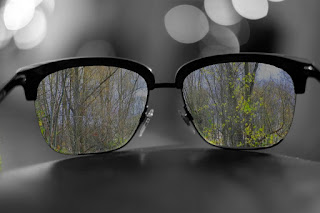For this image I relied heavily on formal elements such as tone, colour and contrast in order to express elements of hyperreality. The idea of this representation of hyperreality is that the world we perceive is different from what we actually experience. To express this I focused on the glasses, causing the background to fade into obscurity. Within the lens of the glasses, a completely different environment can be seen. This environment contrasts greatly with the background as the audience are presented with a sharp, colourful landscape compared to the blurred, dark background. I have enhanced these contrasts through the use of a black and white filter. This draws connotations to dulness within the background while everything within the frame of the glasses appears vibrant. Using these aspects, I have attempted to create a visual representation of hyperreality and its effect. Everything outside of the frame represents the real world as being dull while the lens represents the world that we create in our minds through hyperreality as being vibrant. The fact that the glasses are in focus but the background isn't implies how we choose to ignore our reality and indulge the hyperreality that appeals more to us.
This image features a focus on a pair of glasses while the rest of the frame is out of focus. The setting of the image appears very simplistic as it appears to take place down the walkway of a street. This is a common sight for most people within their everyday lives. This image stands out from what takes place within the frame of the glasses. The extremely small scale of the background is heavily contrasted by the images within the glasses. It appears as if cosmic elements are featured within the lens and vast galaxies and constellations are used. This allows audiences to experience the mindset of the person who wears these glasses as their outlook on life is represented as being very positive and filled with wonder instead of viewing it as being boring or mundane. While the area around the glasses appear quite colourful, using colours which offer connotations to positivity the lens of the glasses features colours that aren't present anywhere else within the frame, evoking an otherworldly feeling.
Both of these images relate under a number of factors. The composition of the images are almost identical, as they both have a massive focus on the glasses while everything in the background remains blurred. Both images use perspective in an interesting way as they make the surrounding frame seem very boring compared to whatever is happening within the lens through the use of colour and the use of different settings. Both of these images focus on people's perceptions of the world. The people within the image choose to ignore their boring reality in favour of a more extraordinary perception of a hyperreality.







